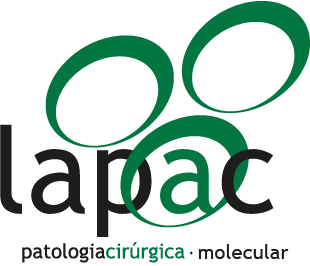Ensino e Pesquisa
First Glance of Molecular Profile of Atypical Cellular Angiofibroma/Cellular Angiofibroma with Sarcomatous Transformation by Next Generation Sequencing
Severe Kala-azar and seric level of IL-6: case reports
Lobular carcinoma of the breast with metastasis to the uterine cervix
A rare case of primary breast angiosarcoma in a male: a case report
Background: Sarcomas account for less than 1% of primary breast cancers, and breast angiosarcomas are responsible for only 0.05% of all breast malignancies. The male breast has the same potential for malignant transformation as the female breast. However, due to anatomical differences in the breast and the low incidence of angiosarcoma, it is difficult to determine how male breasts can be affected by this type of tumor
Case presentation: A 36-year-old male patient was admitted to the hospital with a palpable lump in his right breast. Lymphadenopathy was negative. Ultrasonography showed a hypoechoic mass with partially defined contours, measuring 4.0 × 3.0 cm, with muscle infiltration. Histological examination revealed a malignant tumor. Radical mastectomy was then performed with clear surgical margins. The patient began chemotherapy with paclitaxel. Following the second cycle of chemotherapy, he presented with headache and seizures due to a frontal lobe metastasis. Twenty days after the onset of neurological symptoms, the patient died.
Conclusions: Primary angiosarcomas of the male breast are extremely rare. This is the sixth case published in the literature. It is in agreement with other studies in the literature concerning clinical presentation and poor prognosis. Treatment consists in surgical removal of the tumor with clear margins and without axillary lymphadenectomy
PAGET'S DISEASE OF THE BREAST: STUDY OF CASES SERIES / Doença de Paget na mama: estudo de uma série de casos
Objective: To evaluate the survival of a series of patients with Paget's disease of the breast.
Methods: Observational, retrospective and descriptive study. Data were collected through electronic medical records; the following variables were obtained age, tumor histology, tumor size, degree of differentiation, lymphatic invasion, vascular invasion, neural invasion, presence or not of potential involvement of axillary lymph nodes, immunohistochemical profile, treatments performed, recurrence, and follow-up.
Results: Of the 301 cases of assisted breast cancer, six patients were identified with Paget's disease of the breast. The overall survival, with a mean follow-up of 54 months, was 100%. All individuals are free of disease activity. The most common histochemical profile was negative for estrogen and progesterone receptors, and positive for HER-2/neu. Axillary and/or distal metastatic involvement was not identified.
Conclusions: Overall survival was 100%, with a mean follow-up of 54 months. This high rate is due to the absence of axillary and/or distal metastatic involvement in our series.
Immunohistochemical evaluation of p53 and Ki-67 proteins in colorectal adenomas
Context: The appearance of adenomas and their progression to adenocarcinomas is the result of an accumulation of genetic changes in cells of the intestinal mucosa inherited or acquired during life. Several proteins have been studied in relation to the development and progression of colorectal cancer, including tumor protein p53 (p53) and antigen identified by monoclonal antibody Ki-67 (Ki-67). Objective - To evaluate the expression of p53 and Ki-67 in colorectal adenomas and correlate the observed levels with clinical and pathologic findings. Method - The sample consisted of 50 adenomatous polyps from patients undergoing colonoscopy. After performing polypectomy, polyps were preserved in a formalin solution with 10% (vol./vol.) phosphate buffer, submitted for routine preparation of sections and slides and stained with hematoxylin and eosin. For each adenoma we then performed immunohistochemistry to detect specific p53 and Ki-67 proteins using a streptavidin-biotin-peroxidase enzyme immunoassay.
Results: p53 was detected in 18% of the adenomas. The average Ki-67 protein index (i.Ki-67) was 0.49. A statistically significant difference was observed in p53 (P = 0.0003) and Ki-67 (P = 0.02) expression between adenomas with low- and high-grade dysplasia, particularly for p53. The expression of Ki-67 was greater in rectal adenomas than in colic adenomas (P = 0.02). No relationship was found between the expression of the two proteins in the sample. Conclusion - The p53 protein is expressed in a proportion of adenomas, while the Ki-67 protein was expressed in all adenomas. The expression of p53 was higher in adenomas with high-grade dysplasia. The expression of Ki-67 was higher in rectal adenomas and in adenomas with high-grade dysplasia.
UNIDADE TERESINA
-
R. Anísio de Abreu, 502
-
Centro Sul – Teresina/PI
-
(86) 3221-9141
-
(86) 3223-9757
UNIDADE PARNAÍBA
-
Av. Presidente Vargas, 849 – Sala 2
-
Centro – Parnaíba/PI
-
(86) 3321-1571
UNIDADE BACABAL
-
R. Barão de Capanema, 185
-
Centro – Bacabal/MA
-
(99) 98517-0739
UNIDADE FLORIANO
-
Av. Euripedes de Aguiar, 546
-
Centro – Floriano/PI
-
(89) 99419-7010
Olá! Fale com o Lapac pelo WhatsApp.
